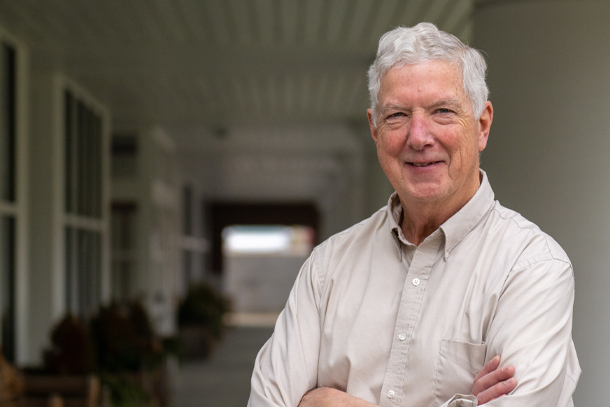
Jim Freihaut, professor and interim head of Penn State’s Department of Architectural Engineering, was recently awarded a three-year, $3 million grant from the U.S. Credit: Jeff Xu/Penn State
Greener power solutions for communities
Q&A with distributed energy system expert Jim Freihaut
March 28, 2024
By Mariah R. Lucas
UNIVERSITY PARK, Pa. — Jim Freihaut, professor and interim head of Penn State’s Department of Architectural Engineering, was recently awarded a three-year, $3 million grant from the U.S. Department of Energy (DOE).
Freihaut will lead a team of engineers and scientists from Pace University, Frontier Energy, Integrated Combined Heat & Power Systems Corporation, the Pennsylvania Technical Assistance Program at Penn State (PennTAP) and the Delaware Valley Industrial Resource Center. The team will provide technical assistance for various potential adopters of onsite distributed energy systems in seven northeast states and Washington, D.C., with the goal of increasing energy infrastructure resilience and providing an economically viable path to net zero carbon operation of the sites.
They also will educate the public and policymakers about onsite distributed energy systems to promote energy generation technologies that can immediately reduce global warming emissions associated with power site operations.
Penn State News caught up with Freihaut about the project:
Q: What are distributed energy systems and how will the project team promote them?
Freihaut: Distributed energy systems are onsite, integrated, dynamically coordinated technologies that can replace the thermal and electrical energy demands currently met by traditional centralized energy infrastructure. The traditional system usually consists of a separate fossil-fuel fired heat production component, such as a boiler or a furnace, and the purchase of electricity from the central electric grid system via the local electric utility provider. The current fossil-fuel based, central electric system is inherently inefficient, as only about 35% to 40% of the fuel energy is delivered as electricity to a site and results in enormous emissions of global warming gases. The remainder of the fuel energy is rejected into local cooling towers or adjacent large bodies of water. By contrast, a well-designed onsite, hybrid energy system routinely converts 70% to 90% of the primary fuel potential energy into useful energy in the simultaneous production of heat and electricity, while ensuring decoupling from the central grid weather, operational and cyber vulnerabilities.
Given the dynamic energy needs of a site operation, our team will identify a combination of technologies — such as combined heat and power systems, solar photovoltaic cells, thermal and electric storage components, heat pumps or “waste” heat recovery technologies — that can meet the energy needs of a facility or community. Having established a hybrid energy system, our team will then perform an analysis of the proposed system on the basis of capital costs, operational costs and global warming gas emissions as compared to the existing system.
Despite their many advantages, the initial cost of installing an onsite hybrid energy system presents a significant challenge to an adopter. Using site-specific electric energy and natural gas rates, our team’s analysis presents an estimate of that challenge as well as how long it would take for adopters to achieve net cash flow back in site operational energy cost savings.
Q: Who is seeking to adopt onsite distributed energy systems and why?
Freihaut: To increase operational resiliency and significantly reduce operational global warming gas emissions, many manufacturing corporations, large commercial operations, school campuses and critical response facilities, such as hospitals, places of refuge, fire and police command and operation centers and large data centers, are looking to implement hybrid onsite energy systems. At the same time, the DOE is highly incentivizing the adoption of onsite energy systems through tax incentives in the Inflation Reduction Act to significantly defray initial capital costs incurred in adopting an onsite energy system. Some state authorities are following suit.
Local communities also are exploring ways to take advantage of distributed energy technologies. Communities that operate municipal utility grid systems or rural electric co-ops are considering re-establishing their own electric generation to respond to climate change and vulnerability challenges from weather and cyber-attacks facing the central grid system. These same organizations see local, onsite energy systems as a catalyst to promote local economic growth.
Q: How does the team plan to educate the public and policymakers about distributed energy systems and their potential to lower communities’ carbon footprint?
Freihaut: Policymakers and the public are generally unaware of the capabilities of distributed onsite energy systems and their advantages over a traditional energy infrastructure. We will contact the relevant energy policy agency within each state to discuss energy policies and regulations and the societal assumptions serving as the basis of the policies. In these discussions, we will present an objective view of distributed, carbon reducing, energy efficient technologies that can help achieve the policy goals established or whether a policy change to encourage distributed energy implementation could be helpful.
For example, we have recently been contacted by a policy analysis firm in Washington, D.C., to discuss policies and regulations impacting the implementation of combined heat and power and other onsite electricity generation technologies in New York, Pennsylvania and Maryland.
In addition, we are often asked by groups to give presentations at environmental conferences or town meetings explaining the nature of onsite distributed energy systems.



